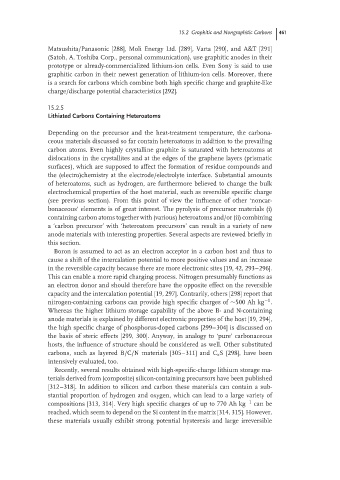Page 488 - Handbook of Battery Materials
P. 488
15.2 Graphitic and Nongraphitic Carbons 461
Matsushita/Panasonic [288], Moli Energy Ltd. [289], Varta [290], and A&T [291]
(Satoh, A. Toshiba Corp., personal communication), use graphitic anodes in their
prototype or already-commercialized lithium-ion cells. Even Sony is said to use
graphitic carbon in their newest generation of lithium-ion cells. Moreover, there
is a search for carbons which combine both high specific charge and graphite-like
charge/discharge potential characteristics [292].
15.2.5
Lithiated Carbons Containing Heteroatoms
Depending on the precursor and the heat-treatment temperature, the carbona-
ceous materials discussed so far contain heteroatoms in addition to the prevailing
carbon atoms. Even highly crystalline graphite is saturated with heteroatoms at
dislocations in the crystallites and at the edges of the graphene layers (prismatic
surfaces), which are supposed to affect the formation of residue compounds and
the (electro)chemistry at the electrode/electrolyte interface. Substantial amounts
of heteroatoms, such as hydrogen, are furthermore believed to change the bulk
electrochemical properties of the host material, such as reversible specific charge
(see previous section). From this point of view the influence of other ‘noncar-
bonaceous’ elements is of great interest. The pyrolysis of precursor materials (i)
containing carbon atoms together with (various) heteroatoms and/or (ii) combining
a ‘carbon precursor’ with ‘heteroatom precursors’ can result in a variety of new
anode materials with interesting properties. Several aspects are reviewed briefly in
this section.
Boron is assumed to act as an electron acceptor in a carbon host and thus to
cause a shift of the intercalation potential to more positive values and an increase
in the reversible capacity because there are more electronic sites [19, 42, 293–296].
This can enable a more rapid charging process. Nitrogen presumably functions as
an electron donor and should therefore have the opposite effect on the reversible
capacity and the intercalation potential [19, 297]. Contrarily, others [298] report that
−1
nitrogen-containing carbons can provide high specific charges of ∼500 Ah kg .
Whereas the higher lithium storage capability of the above B- and N-containing
anode materials is explained by different electronic properties of the host [19, 294],
the high specific charge of phosphorus-doped carbons [299–304] is discussed on
the basis of steric effects [299, 300]. Anyway, in analogy to ‘pure’ carbonaceous
hosts, the influence of structure should be considered as well. Other substituted
carbons, such as layered B/C/N materials [305–311] and C x S [298], have been
intensively evaluated, too.
Recently, several results obtained with high-specific-charge lithium storage ma-
terials derived from (composite) silicon-containing precursors have been published
[312–318]. In addition to silicon and carbon these materials can contain a sub-
stantial proportion of hydrogen and oxygen, which can lead to a large variety of
compositions [313, 314]. Very high specific charges of up to 770 Ah kg −1 can be
reached, which seem to depend on the Si content in the matrix [314, 315]. However,
these materials usually exhibit strong potential hysteresis and large irreversible

